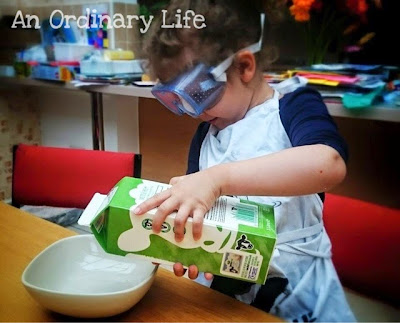You've probably seen this experiment everywhere. It's an old one but a good one and lots of fun for little people.
It involves an explosion of colour too which makes it fun for children but there is also a lot of important science in it too.
If you want to know how to do it yourself, you will need...
- Whole milk
- A dinner plate or bowl
- food colouring a couple of colours is better we only had two in today (you will have to dilute the gel food colourings in a little bit of water to thin it out first though)
- Pipettes (optional but adds to the fun)
- washing up liquid
Now for the fun!
STEP ONE
First pour in the milk so it covers the plate (about 1cm deep).
There might be a few bubbles so let it settle so the surface is smooth.
STEP TWO
Now you get your pipette and squeeze a small amount gently on to the milk in the centre so it looks like this...
STEP THREE
Now for the really fun bit!
You need the washing up liquid in a small container. With a clean pipette, drop a tiny bit of washing up liquid into the centre of your bowl.
Before you do this, remember to hypothesise about what you think will happen - you might want to do this in a science journal.
Before you do this, remember to hypothesise about what you think will happen - you might want to do this in a science journal.
Dip another cotton bud in to your washing up liquid and try again.
At this point you might like to talk about or note down (in your science journal) your observations.
What to do more?
If you want to carry on experimenting do what we done today: try it will semi-skimmed milk, try it will skimmed milk and then try it one more time in water. Remember hypothesis first and observe the reaction.
Which milk is better? The one with higher or lower surface tension.
Does it work in the water too or is it different? Why do you think that is?
How does it work?
Milk is mostly water with about 5% to 10% protein and fat globules (tiny droplets of fat suspended in solution know to scientists as Lipids)but it also contains calcium, vitamins, minerals, salt and carbohydrates.
The fats and proteins in the milk are sensitive to changes in the surrounding solution (the milk) as we learnt about in the curdling the milk experiment and making butter experiment we did a while back.
The beautiful bursting colours is caused due to the chemistry of that tiny drop of soap. Washing up liquid (our soap) has bipolar characteristics; soap is nonpolar on one end and polar on the other. The soap's polar, or hydrophilic (water-loving), end dissolves in water, and the soaps non-polar end, its hydrophobic (water-hating) end, attaches to a fat globule in the milk. This is what weakens the chemical bonds that hold the proteins and fats in solution. This is what alters the solution and causes the effect we can see!
What is making all the colours whirl and swirl and blend? Well it's the molecules of fat, the lipids. They bend, roll, twist, and contort in all directions as the washing up liquid, the soap molecules try to join up with them. The soap molecules combine to form a micelle (a cluster of soap molecules). These micelles distribute the fat in the milk (push them about).
The food colouring is just being bumped about in the process giving us this effect, letting us see what normally isn't visible to the human eye.
You will notice, if you try dipping in more and more washing up liquid the reaction stops. this is because the washing up liquid becomes evenly mixed with the milk, leaving no more lipids for the washing up liquid to chase. Or, to put it another way: when there are micelles and fat droplets everywhere the motion stops. It makes for a great show though.
Of course there is one other reason the colours explode the way they do. Surface tension. As I already said, milk is mostly water therefore has surface tension like water. The drops of food colouring floating on the surface tend to stay put (you do need to keep the liquid steady though). The Liquid soap wrecks the surface tension by breaking the cohesive bonds between water molecules and allowing the colours to zing throughout the milk.
To test this idea out try this experiment again but with water - it's not quite as dramatic but you will see what I mean.
Don't forget to finish your science journals (if you are using one) with a conclusion from what you have learnt!




Wow! that is so interating so much for me to make such things with my daughter very much.
ReplyDelete